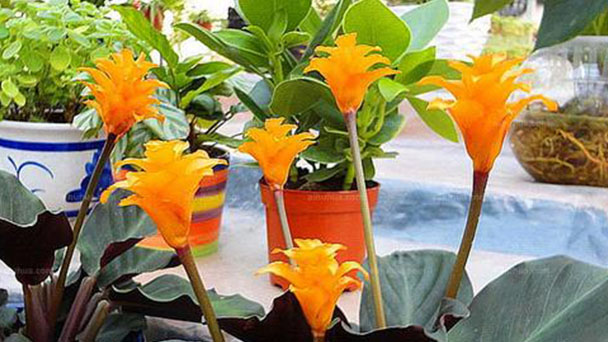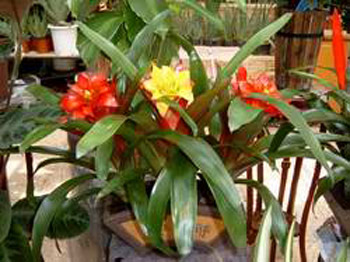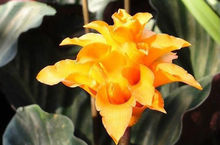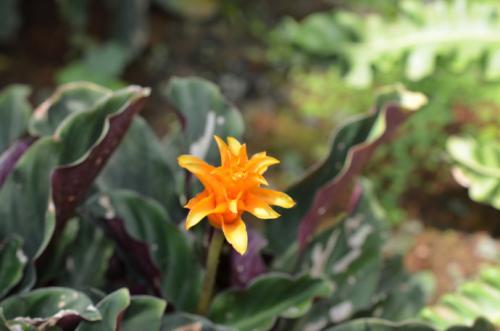How to grow and care for Eternal Flame
Written by Maggie
Jan 07 2021

Eternal Flame is a perennial herbaceous plant of The family Araceae. Its plant is fascicular, the leaf is long elliptic, the leaf margin is a little undulate, the leaf two grey-green to dark green, leaf back dark purplish red. Inflorescences are from leaves, usually higher than the leaves, bracts orange, yellow flowers blooming in winter and spring. It has beautiful flowers with high ornamental value. Many people want to know how to grow and care for Eternal Flame? The following I will introduce the growing and caring tips of Eternal Flame in detail.

How to grow Eternal Flame
The temperature
Eternal Flame is originally produced in tropical and subtropical regions and prefers high temperature, wet and semi-cloudy environments. The suitable growth temperature is 20-30℃. The best growth temperature is 18-21℃ in the daytime and 16-18℃ at night. Therefore, in the summer to prevent high temperature exposure, put it in the shade; In winter we should pay attention to the cold, and can move the plant to no wind, warmer indoor overwintering.
Light
Avoid direct sunlight, in the indirect radiation light or scattering light growth is better. Especially in summer, direct sunlight is easy to cause leaf burns, so the production is cultivated under the artificial light control environment of the shading net with the refraction of 75-80%. If a leaf burn is found, move it immediately to an area with no direct light or shading facilities or under shade trees, and cut off the leaf to prevent other pathogenic bacteria from invading from the wound. At the same time, strengthen the management of water and fertilizer, promote its new leaf, restore a new appearance.
Moisture
March-october of each year is the peak season for the growth of Eternal Flame. The air relative humidity that is most suitable for its growth is 75-85%. High air humidity is conducive to leaf expansion. Especially during the period of new leaf extraction, if it is too dry, the margin and tip of the new leaf are easy to dry up and become deformed in the future. The leaves wilted without recovery. Therefore, in the growing season need to be watered frequently, and often to the leaf spray, every day in summer 3-4 times, and timely, the best watering method is to spray the leaf in the morning, at noon or in the afternoon soil surface, at night the whole plant watering, but pay attention to the soil not too sticky, too wet, otherwise easy root rot and cause diseases. After entering the autumn, winter, Eternal Flame growth slowed down, watering quantity to gradually reduce. According to the weather changes, I decided to water once a day or 2-3 days watering once, especially when the temperature is lower, we should keep the soil dry, so as to avoid cold damage.
Cultivation substrate
Cultivation of fertile soil, loose and good drainage, avoid soil consolidation and water. Fertile humus and porous coarse media are used as substrates. Generally, leaf molds and peat soil are mixed in equal amounts. It can also be mixed with pond mud, peat and perlite in a ratio of 2:3:1. Or it can be made by adding 1/3 perlite to loose leaf rot soil rich in organic matter and a small amount of basal fertilizer.
Fertilization
According to the principle of "frequent application of thin application", the compost of peanut bran and compound fertilizer should be applied every 2 weeks in the peak growing season. The nutrient composition of fertilizer should be mainly nitrogen fertilizer, followed by phosphorus and potassium fertilizer. As Eternal Flame is a leaf-watching plant, appropriate application of nitrogen fertilizer can make the leaves a more beautiful color. In addition, 0.1% solution can be prepared with urea with nitrogen content up to 46%, and 0.2% solution can be prepared with potassium dihydrogen phosphate with phosphorus content more than 50% and potassium content more than 30%, which can be used as topdressing outside the roots. The effect is better when dew is not dry in the morning or in the evening. Spray the front and back of the blade with a fine hole sprayer, spray once a week, stop for 3 times, and then spray continuously. It should be noted that the concentration of fertilization should not be too large, otherwise it is easy to cause leaf burning and fertilizer damage, or even cause plant death in serious cases. Stop fertilizing during winter dormancy and when summer is too hot.

How to care for Eternal Flame
Cultivation management: Potted soil should be loose and fertile. Peat soil or leaf rot soil and a small amount of coarse sand preparation, plus an appropriate amount of organic fertilizer. The overwintering temperature should be no less than 100C. When the summer temperature exceeds 30℃, the growth slows down. Shade resistance, indoor illumination can meet the need of light; Outdoors, it should be placed under the shade or in a 50% shading net. Avoid strong light directly, strong light burns the blade easily. The water requirement is high, not only requires the basin soil to keep moist, but also should be about 70% of the air relative humidity. If the surface of basin soil is a little dry, it should be watered, namely, with water just out of the water hole at the bottom of the basin. Spray water frequently to the leaves and around the plant to increase humidity. In the north, indoor air is dry in winter, which is the most unfavorable factor for plant growth. In addition to regular spraying of water, large plastic bags can be used to cover humidity at night and be taken off in the morning, so as not to affect the viewing. Spring, autumn for the growth season, it can be used every half a month to irrigate the more nitrogenous leaf-viewing fertilizer, available nitrogen, phosphorus, potassium by 2,1,1 0.3 write liquid fertilizer, cool days after stop topdressing. In hot summer, you can also only water without fertilizing, because hot plants almost stop growing, no need for nutrition supply.
[Pest control] Diseases and insect pests do not occur much. Sometimes there will be leaf spot disease, yellow spots produced on the leaves, and then form yellowish-brown spots, which can be used for the prevention and treatment of poly mycorrhizal or chlorothalonil solution spraying. Also produce scale insects to be harmed, usable neuter washing powder liquid gush insect body, form envelopment and make insect body asphyxiation dies. Or spray oxy dimethoate solution several times during the incubation period (late May to June each year). Because adult scale insects have wax in their bodies, drugs are difficult to penetrate and kill the adults. But the larva has no wax outside the body and migrates everywhere, so the spray is easy to destroy.

Latest Updated
- Benefits of Bugleweed - 7 Science-backed Health Benefits
- Bugleweed Dangers & Side Effects - Is It Poisonous?
- How to Plant Evergreen Trees - What You Should Know
- When to Plant Evergreens - Grow Guide for Evergreen Trees
- 12 Wonderful Evergreen Shrubs for Your Garden
- 12 Popular Evergreen Plants with Pictures for Beginners
- When And How To Prune A Lilac Bush Like a Pro
- How to Grow & Care for Lilac Vine (Hardenbergia Violacea)
- Japanese Lilac Tree (Syringa Reticulata) Care & Propagation Guide
- Shumard Oak Pros and Cons - What to Know
Popular Articles
- Winter maintenance of Antirrhinum Majus
- How to Grow Terminalia Mantaly Tree
- How to Grow and Care for Crossostephium Chinense
- How to grow Antirrhinum Majus in spring
- Peristeria Elata (Dove Orchid) Profile: Info & Care Guide
- Underwatered Snake Plant (Sansevieria Trifasciata) - Signs And How To Fix
- How to Care for Brazilian Jasmine Plant (Mandevilla Sanderi)
- How to Grow & Care for Graptopetalum Purple Delight in Summer
- Rosa Chinensis (China Rose): Plant Growing & Care Tips
- How to Care for Baby Sun Rose (Aptenia Cordifolia)